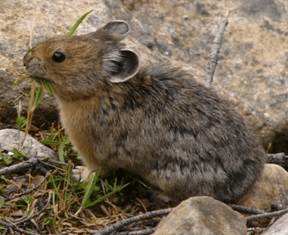Pika in Peril
Air Date: Week of February 19, 2010

The American Pika live in rocky mountainous areas. The mammals don’t hibernate; instead they forage in the summer and make hay to eat over the winter months. (Photo: National Park Service)
Pika, an alpine cousin to the rabbit, are disappearing from parts of the Western United States, but the U.S. Fish and Wildlife Service declined to list the animal on the endangered species list. Host Jeff Young talks to Vermont Law School Professor Pat Parenteau about what this decision says about the Obama administration and endangered species protection.
Transcript
YOUNG: It’s Living on Earth, I’m Jeff Young.
[SOUNDS OF PIKA – SQUEAKING EEEEK]
YOUNG: That’s the sound of the pika, a smallish rodent similar to the chinchilla that’s found throughout the Rocky Mountains from New Mexico to Canada. The pika needs a cool environment. In its southern range it’s found only above 8,000 feet. And there are concerns that a warming climate could push the pika first into smaller, higher habitats and eventually into extinction.
However, the U.S. Fish and Wildlife Service recently declined to include the pika on the nation’s list of threatened and endangered species. It’s just one of many controversial calls the Obama administration has made about species that might be threatened by climate change – like the polar bear.
Environmental law professor Pat Parenteau at the Vermont Law School helps keep us informed on endangered species issues. Prof. Parenteau, welcome back.
PARENTEAU: Thank you, pleasure to be here.
YOUNG: Now, why did Fish and Wildlife Service decline to list this animal, the pika, on the Endangered and Threatened Species list?
PARENTEAU: Basically, the Fish and Wildlife Service determined that because there are many places in the west where there are pika populations that the loss of some portion of the pika’s range and the reduction of habitat in some parts of its range was not enough to justify listing the pika.
YOUNG: Now, last time you and I talked about endangered species and climate change this was one animal you thought would get listing, right, the pika?
PARENTEAU: That’s right. I got proven wrong again when using my crystal ball. My basis for believing that they would go ahead with the listing is that in the case of the polar bear, the decision was that if climate change goes unchecked during the course of this century we’re going to lose the ice cover in the Arctic, and of course, we’re seeing that process unfold even now. And therefore, they made a very long-range projection that the polar bear probably couldn’t survive the loss of all this ice in the Arctic.

Pat Parenteau is a professor of environmental law at the Vermont Law School. (Courtesy of Vermont Law School)
So when you look at the pika, which is a species of mammal, it’s sometimes referred to as the boulder bunny, it’s like a little rabbit, and it lives in a very tiny ecological niche high in the alpine areas of the Rocky Mountains, the Sierra Nevadas, and other mountain areas in the west. And the same process of the loss of its habitat is unfolding. We’ve seen populations of pika disappear. For example, in the Great Basin area of the west, five mountain ranges have seen a loss of almost 40 percent of the pika from those areas, so we know, and the Fish and Wildlife Service acknowledged, that the pika is losing ground to climate change. And I was surprised that given that fact the Fish and Wildlife Service would not have erred on the side of caution and gone ahead and listed the pika, but they didn’t do that.
YOUNG: Well, if it’s any consolation you weren’t the only one who thought that they would list this – the group that sought the petition here, the Center for Biological Diversity, issued a statement after the decision saying, “this is a political decision that ignores science and the law.” What do you make of that statement; do you see any evidence to support that?
PARENTEAU: I think that’s probably too strong in terms of ignoring the science. The decision the Service made took into account all of the available science on climate change, but I do agree that there’s a serious question about whether the Service follow the requirements of the Endangered Species Act.

The American Pika live in rocky mountainous areas. The mammals don’t hibernate; instead they forage in the summer and make hay to eat over the winter months. (Photo: National Park Service)
They’re taking an approach which says the species has to basically prove it’s entitled to the protections of the Act, whereas I think the Act was really designed to be the reverse – to put a thumb on the scale, if you will, to protect the species where you’re not positive or certain that it’s at risk, but there’s enough evidence to justify taking a more precautionary approach.
The existing science clearly supports listing the species. They opted instead to say there are aspects of this species’ survival and biology that may enable it to survive even the threats – serious threats – from climate change. They took a narrow and somewhat conservative view of what the science was saying about the threats to this species and decided not to give it protection.
YOUNG: So what does this tell us about the Obama administration’s general attitude toward endangered species?
PARENTEAU: Well, we knew right off the bat with the polar bear listing when the Obama administration followed the lead of the previous Bush administration by saying that the Endangered Species Act was not intended to be used to address the causes of climate change, namely greenhouse gas sources. We knew from that point that this administration really was reluctant to use the Endangered Species Act in that way.
I think that pika decision is further evidence of that, so I’d have to say it appears as if the Obama administration is putting all of its chips on getting climate legislation through the Congress, and of course that’s a very speculative proposition at this point. And the unfortunate thing I think from the standpoint of species that are already experiencing impacts from climate change is that there really is no other statutory mechanism that we have, no law on the books that provides any protection for them, so not to use the one tool we do have strikes me as not a very sound policy.
YOUNG: So if the thinking is this is not an appropriate use of the Endangered Species Act to address climate change, well, then what do you do about these animals where that’s the primary threat?
PARENTEAU: That’s a very good question, and my answer to that would be I don’t see another tool that’s available under the law that could possibly provide protection for this kind of a species. There really isn’t any other threat to this species of any significance. It would be doing fine but for climate change.
And the fact of the matter is we have no effective regulation on greenhouse gas emissions and we do not know when – if ever – we will get such a regulation. So, the only thing that can be done in the meantime is to use existing tools like the Endangered Species Act, the National Environmental Policy Act, the Clean Air Act. These are old tools, it’s true, and they’re not adequate to deal with all the entire threat of climate change, but we have to use the tools we have – it’s all we have at our disposal.
YOUNG: Pat Parenteau, environmental law professor at the Vermont Law School. Thanks very much.
PARENTEAU: Thank you, Jeff.
Watch a day in the life of a pika.
Links
Living on Earth wants to hear from you!
Living on Earth
62 Calef Highway, Suite 212
Lee, NH 03861
Telephone: 617-287-4121
E-mail: comments@loe.org
Newsletter [Click here]
Donate to Living on Earth!
Living on Earth is an independent media program and relies entirely on contributions from listeners and institutions supporting public service. Please donate now to preserve an independent environmental voice.
NewsletterLiving on Earth offers a weekly delivery of the show's rundown to your mailbox. Sign up for our newsletter today!
 Sailors For The Sea: Be the change you want to sea.
Sailors For The Sea: Be the change you want to sea.
 The Grantham Foundation for the Protection of the Environment: Committed to protecting and improving the health of the global environment.
The Grantham Foundation for the Protection of the Environment: Committed to protecting and improving the health of the global environment.
 Contribute to Living on Earth and receive, as our gift to you, an archival print of one of Mark Seth Lender's extraordinary wildlife photographs. Follow the link to see Mark's current collection of photographs.
Contribute to Living on Earth and receive, as our gift to you, an archival print of one of Mark Seth Lender's extraordinary wildlife photographs. Follow the link to see Mark's current collection of photographs.
 Buy a signed copy of Mark Seth Lender's book Smeagull the Seagull & support Living on Earth
Buy a signed copy of Mark Seth Lender's book Smeagull the Seagull & support Living on Earth

